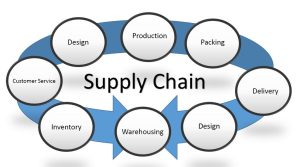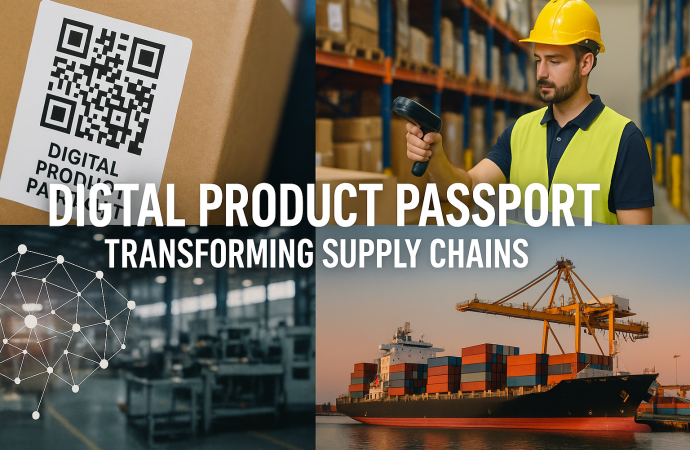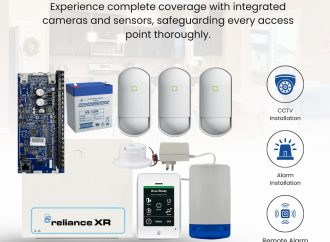Introduction Imagine scanning a sneaker’s QR code and seeing every stop it made—cotton farm, dye house, factory line, ship manifest, and even its future recycling center. That transparent file is called a Digital Product Passport (DPP), and regulators and brands agree it will soon be as common as barcodes. Driven by the European Union’s Green
Introduction
Imagine scanning a sneaker’s QR code and seeing every stop it made—cotton farm, dye house, factory line, ship manifest, and even its future recycling center. That transparent file is called a Digital Product Passport (DPP), and regulators and brands agree it will soon be as common as barcodes. Driven by the European Union’s Green Deal and rising consumer demand for proof of origin, DPPs promise to make supply chains cleaner, smarter, and more resilient. This article explains what digital product passports are, why they matter, and how companies can start the journey from opaque logistics to data-rich transparency.
What Is a Digital Product Passport?
A digital product passport is a structured data file that travels with a physical item across its life cycle. Unlike a simple label, a passport evolves: suppliers upload material certificates, factories add batch IDs, retailers log sales, and recyclers record the item’s second life. The file sits on cloud servers or blockchain networks and is accessed through a QR code, NFC chip, or digital watermark on the product.
Why Supply Chains Need Passports Now

Image by: Yandex.com
Regulatory Push
The EU’s Ecodesign for Sustainable Products Regulation (ESPR) mandates DPPs for batteries in 2025, textiles in 2026, and consumer electronics by 2027. Non-compliant goods face border holds and fines. Other regions—from Canada to South Korea—signal similar rules.
Consumer Trust Gap
A 2024 Deloitte survey showed 62 % of shoppers doubt “sustainable” claims. Passports give verifiable proof—organic cotton certificates, low-carbon shipping logs—that turns doubt into purchase.
Inefficient Recalls
When a supplier’s error surfaces, brands often yank entire product lines. With unit-level data, recalls target only affected lots, saving millions and sparing brand reputation.
Circular Economy Goals
Passports list material composition and disassembly instructions, helping recyclers recover fibers or metals and letting resale platforms grade item authenticity.
How Digital Passports Transform Workflow
Real-Time Traceability
Sensors and IoT tags feed location and temperature data straight into the passport. Quality teams spot delays or spoilage and reroute shipments before stockouts occur.
Automated Compliance
Smart contracts on blockchain trigger alerts if a batch lacks needed certificates. Customs brokers see green checkmarks and speed shipments.
Data-Driven Design
Product teams study passport feedback—high repair rates on zippers, for instance—and redesign weak components in the next season.
Loyalty & Resale
Brands scan returned goods, verify authenticity, and issue instant store credit, fueling buy-back programs. Customers resale items with QR proof, upping residual value.
Building a Passport System: Step-by-Step

Image by: Yandex.com
Map Data Needs
List mandatory fields from upcoming regulations and voluntary labels (Fairtrade, GOTS). Rank by feasibility and impact.
Choose Your Tech Stack
- Centralized cloud—fast deployment, simpler queries.
- Blockchain—immutable records, shared governance, higher cost.
Most firms run hybrid: sensitive carbon data on cloud, chain-of-custody hashes on blockchain.
Set Data Standards
Adopt existing schemas—GS1 Digital Link, ISO/IEC 22603—to avoid lock-in. Create a data dictionary so every supplier tags fields the same way.
Onboard Partners
Pilot with one product line and three suppliers. Provide API keys or low-code portals. Offer training webinars and shared dashboards.
Attach Digital Identifier
Pick QR for low cost or NFC for durability. Embed code in care label, shoebox, or casting mold.
Test, Audit, Iterate
Run a mock recall to verify traceability. Audit random passports for missing fields. Scale once error rates fall below 2 %.
Cost vs. Benefit Analysis
| Item | One-Time Cost | Annual Cost | Direct ROI |
|---|---|---|---|
| Platform license | $120 k | $35 k | 10 % shorter lead-time |
| QR printing | $0.01 per unit | — | 30 % fewer counterfeit returns |
| Supplier onboarding | $20 k | — | Faster compliance clearance |
| Staff training | $15 k | $5 k refresh | Lower recall expense |
McKinsey estimates fashion brands can recover 3-5 % of revenue via resale programs enabled by DPPs—often paying back setup costs within two years.
Practical Tips for Successful Adoption

Image by: Yandex.com
To maximize value, follow these best practices.
Start with a Pilot
Choose one product category or market to pilot DPPs. Track key metrics like data accuracy, recall speed, and customer engagement. Use early insights to refine processes before scaling.
Define Clear Data Ownership
Assign responsibility for each data field. Ensure suppliers know which information to feed into the DPP and when. Clear accountability fosters reliable data flows.
Invest in Training
Employees across procurement, quality, logistics, and customer service need training on DPP tools. Provide easy-to-use guides and hands-on workshops.
Monitor and Iterate
Regularly review DPP performance metrics. Look for data gaps, late entries, or compliance issues. Use dashboards to spot trends and continuously improve data quality.
Challenges and Fixes
- Data Overload – Start small. Only 20 fields cover 80 % of regulatory needs.
- Supplier Pushback – Offer volume-based incentives or shared carbon credits.
- Consumer Privacy – Store personal info off-chain; passports hold anonymous owner IDs.
- Interoperability – Join industry consortia (Catena-X for auto, CIRPASS for electronics) to sync standards.
Future Outlook: Beyond Compliance
- AI Predictive Maintenance – Passports feed machine-learning models that predict part failure and auto-order spares.
- Tokenized Incentives – Users earn loyalty tokens when they resell or recycle, encouraging circular habits.
- Regenerative Supply Chains – Passport carbon data triggers offset purchases, nudging suppliers toward renewable energy.
Conclusion
Digital product passports turn every item into a storyteller, revealing its journey from raw material to recycling bin. They promise legal compliance, transparent sourcing, smarter recalls, and a path to circular business models. Companies that build passport systems now will not only dodge regulatory fines but also gain brand trust and data insights most rivals still lack. Start by mapping essential data, selecting scalable tech, and piloting with a flagship product. The sooner your products carry passports, the smoother your supply chain will travel in the data-driven decade ahead.
Call-to-Action: Ready to launch your first digital product passport pilot? Download our free checklist and vendor comparison matrix to kick-start your project today.






















